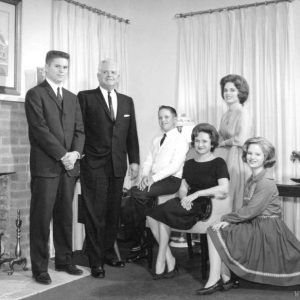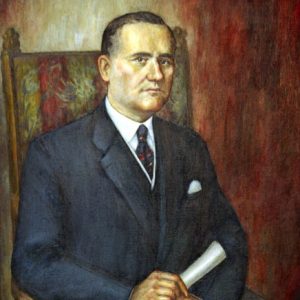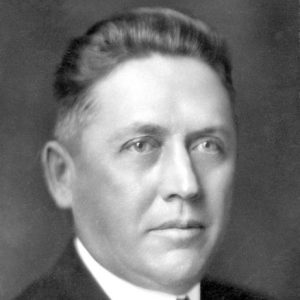calsfoundation@cals.org
Harvey Parnell (1880–1936)
Twenty-ninth Governor (1928–1933)
Harvey Parnell was the first lieutenant governor of the twentieth century and twenty-ninth governor of Arkansas. During his term as governor, he appointed Hattie Caraway to the U.S. Senate. She later became the first woman elected to the U.S. Senate.
Harvey Parnell was born in Orlando (Cleveland County) on February 28, 1880, to William Robert Parnell, a farmer, and Mary Elizabeth Martin. He shared farm chores with four brothers and two sisters. He was educated in the one-room schoolhouses of rural Arkansas. At the age of eighteen, he moved to Warren (Bradley County), where he attended high school and worked in the local hardware store.
Parnell’s early career as a small business owner and farmer influenced his later career as a political progressive. On June 2, 1902, he married Mabel Winston and settled on a large farm near Crooked Bayou (Chicot County), where he raised cattle on several thousand acres. The couple had two daughters.
The Democrat from Chicot County first entered politics in 1919 as a member of the state House of Representatives. His was a silent but consistent vote in the Forty-second General Assembly that endorsed main stream reform measures adopted by the national Democratic Party. Dubbed “Progressives,” these legislators rallied behind women’s suffrage, the child labor amendment, and Prohibition. After his election to the state Senate in 1923, Parnell joined other “business progressives” across the South who believed that improving state services, building roads, and modernizing public schools would attract industry and manufacturing interests to a state where eighty percent of the population listed “farmer” as their occupation. As Parnell explained it, “all manufacturing establishments are in states with good school systems.” He also believed that the state’s responsibility to expand and improve public services carried with it the power to raise the revenue for these services. He introduced and fought for the passage of luxury and license taxes, as well as the state’s first income tax, which provided millions of dollars annually for roads and schools.
In 1926, the state Supreme Court settled a constitutional dispute in the case of Combs v. Gray, deciding that the office of lieutenant governor had been created in an earlier state election, and a prominent government post was declared vacant. Parnell announced his candidacy and became the first lieutenant governor of Arkansas later that year. As lieutenant governor, Parnell presided over the state Senate, offering enthusiastic support for the road-building legislation of a fellow business progressive, Governor John Ellis Martineau.
Parnell did not seize opportunity so much as it seized him. In the spring of 1928, barely a year into Parnell’s term of office as the state’s first lieutenant governor, Martineau accepted an appointment to a federal judgeship. As the constitutional next-in-line, Parnell filled this vacancy and, for the next six months, fielded his next election prospects from the governor’s mansion.
Local party bosses, county patronage rolls, and friends and acquaintances Parnell had made as a member of the Arkansas General Assembly for almost a decade became known as the “Parnell machine” in the gubernatorial campaigns of 1928 and 1930. His bid for office in 1928 against Tom J. Terral was particularly plagued with charges of campaign finance irregularities.
For the next two years, Parnell set out to make his campaign rhetoric a reality with an attack on what he called the three outstanding problems in Arkansas: taxation, education, and rural highways.
In 1929, the Arkansas legislature finally enacted a state income tax to help fund an assortment of Parnell’s development projects, such as school modernization. However, the stock-market crash and a devastating drought the following summer deprived much of rural Arkansas of any real income. Parnell’s energetic efforts to improve state services and facilities meant that the state treasury had no reserve funds for emergency relief, an issue hotly debated with Brooks Hays in the August 1930 Democratic gubernatorial primary. By the fall of that year, Parnell easily won his second elected term as governor, promising that an elaborate reorganization of state government might ease Arkansas’s economic plight. It was during this term that Parnell appointed Hattie Caraway to fill the U.S. Senate seat of her husband, Thaddeus Caraway, after his death. Hattie Caraway later became the first woman elected to the U.S. Senate.
Relief legislation battled Parnell’s reform agenda at each session of the Arkansas General Assembly. In the midst of an unprecedented banking crisis and a food riot staged by farmers in England (Lonoke County), Parnell assured desperate Arkansans that self-help and private charities would bring economic recovery. By the end of 1932, during the worst of the Great Depression, Arkansas had exhausted its share of relief from the resources of the Reconstruction Finance Corporation and the Red Cross. While the state grew increasingly dependent on federal aid, Parnell appointed commissions to study unemployment, raise taxes, and secure funding for highway construction.
Amid charges that his administration was ineffective, if not outright corrupt, Parnell salvaged a few items from his reform agenda. The long-awaited compulsory school attendance law was among the flood of much-needed emergency relief legislation. As Arkansas embraced the New Deal in 1933, Parnell retired from politics.
Parnell died on January 16, 1936, in St. Vincent Infirmary in Little Rock (Pulaski County) after suffering two heart attacks. He is buried in Roselawn Memorial Park in Little Rock.
For additional information:
Donovan, Timothy P., and Willard B. Gatewood Jr., and Jeannie M. Whayne, eds. The Governors of Arkansas: Essays in Political Biography. 2d ed. Fayetteville: University of Arkansas Press, 1995.
Harvey Parnell Collection. Special Collections. University of Arkansas Libraries, Fayetteville, Arkansas.
Murray, Gail S. “Forty Years Ago: The Great Depression Comes to Arkansas.” Arkansas Historical Quarterly 29 (Winter 1970): 291–312.
Pamela Salamo
Fayetteville, Arkansas
This entry, originally published in Arkansas Biography: A Collection of Notable Lives, appears in the CALS Encyclopedia of Arkansas in an altered form. Arkansas Biography is available from the University of Arkansas Press.


 Parnell Family
Parnell Family  Harvey Parnell
Harvey Parnell  Harvey Parnell
Harvey Parnell 




Comments
No comments on this entry yet.